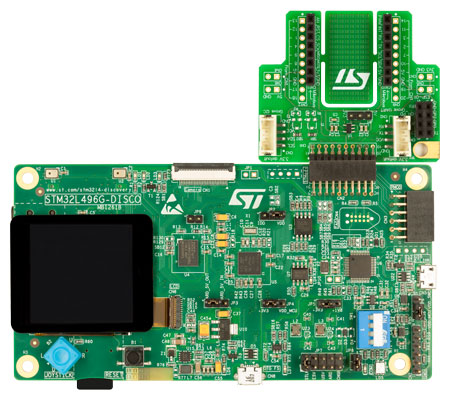ST STM32L496G Discovery¶
Overview¶
The STM32L496G Discovery board features an ARM Cortex-M4 based STM32L496AG MCU with a wide range of connectivity support and configurations. Here are some highlights of the STM32L496G Discovery board:
STM32L496AGI6 microcontroller featuring 1 Mbyte of Flash memory and 320 Kbytes of RAM in an UFBGA169 package
1.54 inch 240 x 240 pixel-TFT color LCD with parallel interface
SAI Audio CODEC, with a stereo headset jack, including analog microphone input
Stereo digital MEMS microphones
microSD card connector (card included)
Camera 8 bit-connector
8 Mbit-PSRAM
IDD measurement
64 Mbit-Quad-SPI Flash
USB OTG FS with Micro-AB connector
Two types of extension resources:
- STMod+ and PMOD connectors
- Compatible Arduino* Uno V3 connectors
On-board ST-LINK/V2-1 debugger/programmer with SWD connector
5 source options for power supply
- ST-LINK/V2-1 USB connector
- User USB FS connector
- VIN from Arduino connector
- 5 V from Arduino connector
- USB charger
- USB VBUS or external source(3.3V, 5V, 7 - 12V)
- Power management access point
8 LEDs
Reset push button
4 direction-joystick with selection

More information about the board can be found at the STM32L496G Discovery website.
Hardware¶
The STM32L496AG SoC provides the following hardware capabilities:
Ultra-low-power with FlexPowerControl (down to 108 nA Standby mode and 91 µA/MHz run mode)
Core: ARM® 32-bit Cortex® -M4 CPU with FPU, frequency up to 80 MHz, 100DMIPS/1.25DMIPS/MHz (Dhrystone 2.1)
Clock Sources:
- 4 to 48 MHz crystal oscillator
- 32 kHz crystal oscillator for RTC (LSE)
- Internal 16 MHz factory-trimmed RC ( ±1%)
- Internal low-power 32 kHz RC ( ±5%)
- Internal multispeed 100 kHz to 48 MHz oscillator, auto-trimmed by LSE (better than ±0.25 % accuracy)
- Internal 48 MHz with clock recovery
- 3 PLLs for system clock, USB, audio, ADC
RTC with HW calendar, alarms and calibration
LCD 8 x 40 or 4 x 44 with step-up converter
Up to 24 capacitive sensing channels: support touchkey, linear and rotary touch sensors
16x timers:
- 2x 16-bit advanced motor-control
- 2x 32-bit and 5x 16-bit general purpose
- 2x 16-bit basic
- 2x low-power 16-bit timers (available in Stop mode)
- 2x watchdogs
- SysTick timer
Up to 136 fast I/Os, most 5 V-tolerant, up to 14 I/Os with independent supply down to 1.08 V
Memories
- Up to 1 MB Flash, 2 banks read-while-write, proprietary code readout protection
- 320 KB of SRAM including 64 KB with hardware parity check
- External memory interface for static memories supporting SRAM, PSRAM, NOR, and NAND memories
- Quad SPI memory interface
4x digital filters for sigma delta modulator
Rich analog peripherals (independent supply)
- 3x 12-bit ADC 5 MSPS, up to 16-bit with hardware oversampling, 200 µA/MSPS
- 2x 12-bit DAC, low-power sample and hold
- 2x operational amplifiers with built-in PGA
- 2x ultra-low-power comparators
20x communication interfaces
- USB OTG 2.0 full-speed, LPM and BCD
- 2x SAIs (serial audio interface)
- 4x I2C FM+(1 Mbit/s), SMBus/PMBus
- 5x USARTs (ISO 7816, LIN, IrDA, modem)
- 1x LPUART
- 3x SPIs (4x SPIs with the Quad SPI)
- 2x CAN (2.0B Active) and SDMMC interface
- SWPMI single wire protocol master I/F
- IRTIM (Infrared interface)
14-channel DMA controller
True random number generator
CRC calculation unit, 96-bit unique ID
Development support: serial wire debug (SWD), JTAG, Embedded Trace Macrocell*
- More information about STM32L496AG can be found here:
Supported Features¶
The Zephyr stm32l496g_disco board configuration supports the following hardware features:
| Interface | Controller | Driver/Component |
|---|---|---|
| NVIC | on-chip | nested vector interrupt controller |
| UART | on-chip | serial port-polling; serial port-interrupt |
| PINMUX | on-chip | pinmux |
| GPIO | on-chip | gpio |
| I2C | on-chip | i2c |
| PWM | on-chip | pwm |
Other hardware features are not yet supported on this Zephyr port.
The default configuration can be found in the defconfig file:
boards/arm/stm32l496g_disco/stm32l496g_disco_defconfig
Connections and IOs¶
STM32L496G Discovery Board has 8 GPIO controllers. These controllers are responsible for pin muxing, input/output, pull-up, etc.
For mode details please refer to STM32L496G Discovery board User Manual.
Default Zephyr Peripheral Mapping:¶
- UART_1_TX : PB6
- UART_1_RX : PG10
- UART_2_TX : PA2
- UART_2_RX : PD6
- I2C_1_SCL : PB8
- I2C_1_SDA : PB7
- PWM_2_CH1 : PA0
- LD2 : PB13
System Clock¶
STM32L496G Discovery System Clock could be driven by internal or external oscillator, as well as main PLL clock. By default System clock is driven by PLL clock at 80MHz, driven by 16MHz high speed internal oscillator.
Serial Port¶
STM32L496G Discovery board has 5 U(S)ARTs. The Zephyr console output is assigned to UART2. Default settings are 115200 8N1.
Programming and Debugging¶
Flashing¶
STM32L496G Discovery board includes an ST-LINK/V2-1 embedded debug tool interface. This interface is not supported by the openocd version 0.9 included by the Zephyr SDK v0.9, use openocd v0.10.0 from the openocd-stm32 project on GitHub to get the minimum set of scripts needed to flash and debug STM32 development boards.
$ git clone https://github.com/erwango/openocd-stm32.git
Then follow instructions in README.md
Flashing an application to STM32L496G Discovery¶
The sample application Hello World is being used in this tutorial:
To build the Zephyr kernel and application, enter:
$ cd <zephyr_root_path>
$ source zephyr-env.sh
$ cd $ZEPHYR_BASE/samples/hello_world/
$ make BOARD=stm32l496g_disco
Connect the STM32L496G Discovery to your host computer using the USB port. Then, enter the following command:
$ cd <openocd-stm32_path>
$ stm32_flsh l4 $ZEPHYR_BASE/samples/hello_world/outdir/stm32l496g_disco/zephyr.bin
Run a serial host program to connect with your Discovery board.
$ minicom -D /dev/ttyACM0
You should see the following message:
$ Hello World! arm
Debugging¶
Access gdb with the following make command:
$ cd <openocd-stm32_path>
$ stm32_dbg l4 $ZEPHYR_BASE/samples/hello_world/outdir/stm32l496g_disco/zephyr.elf